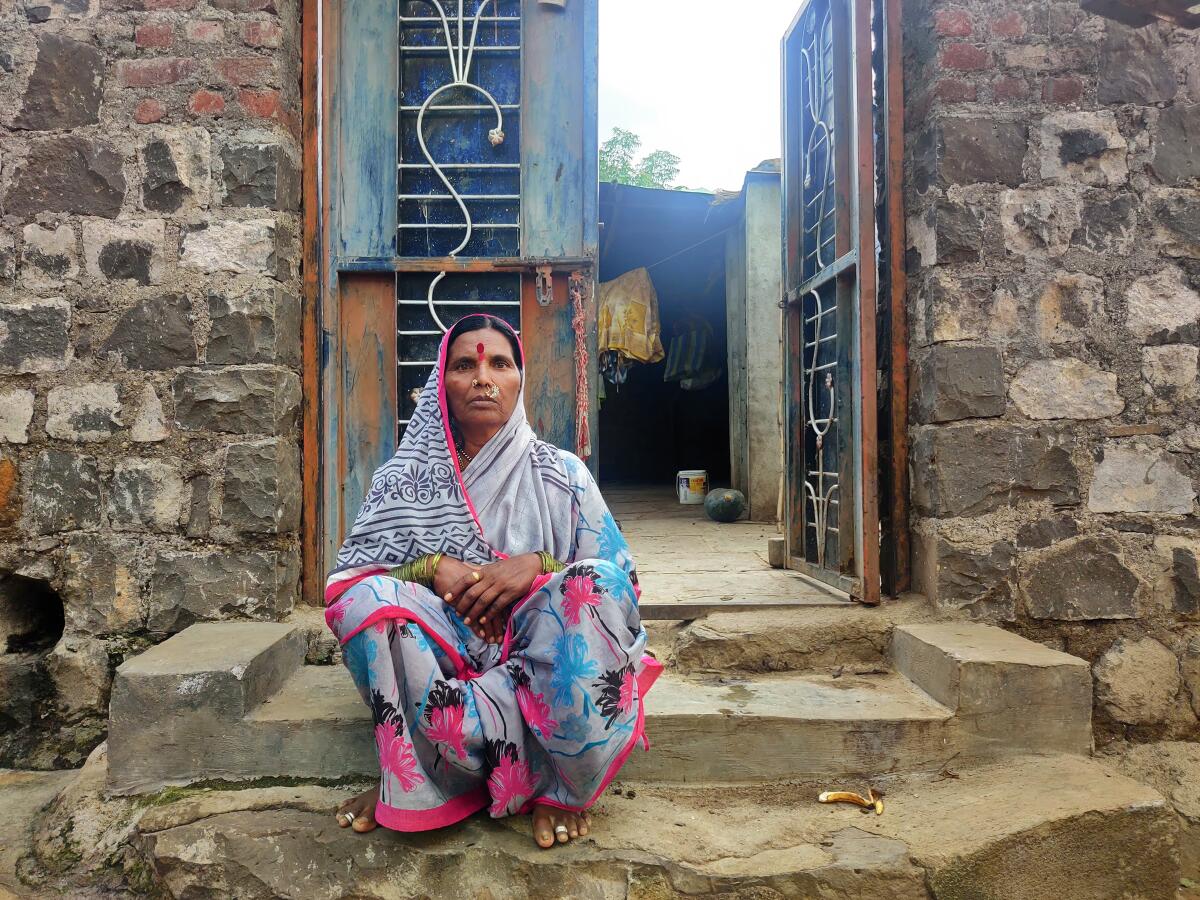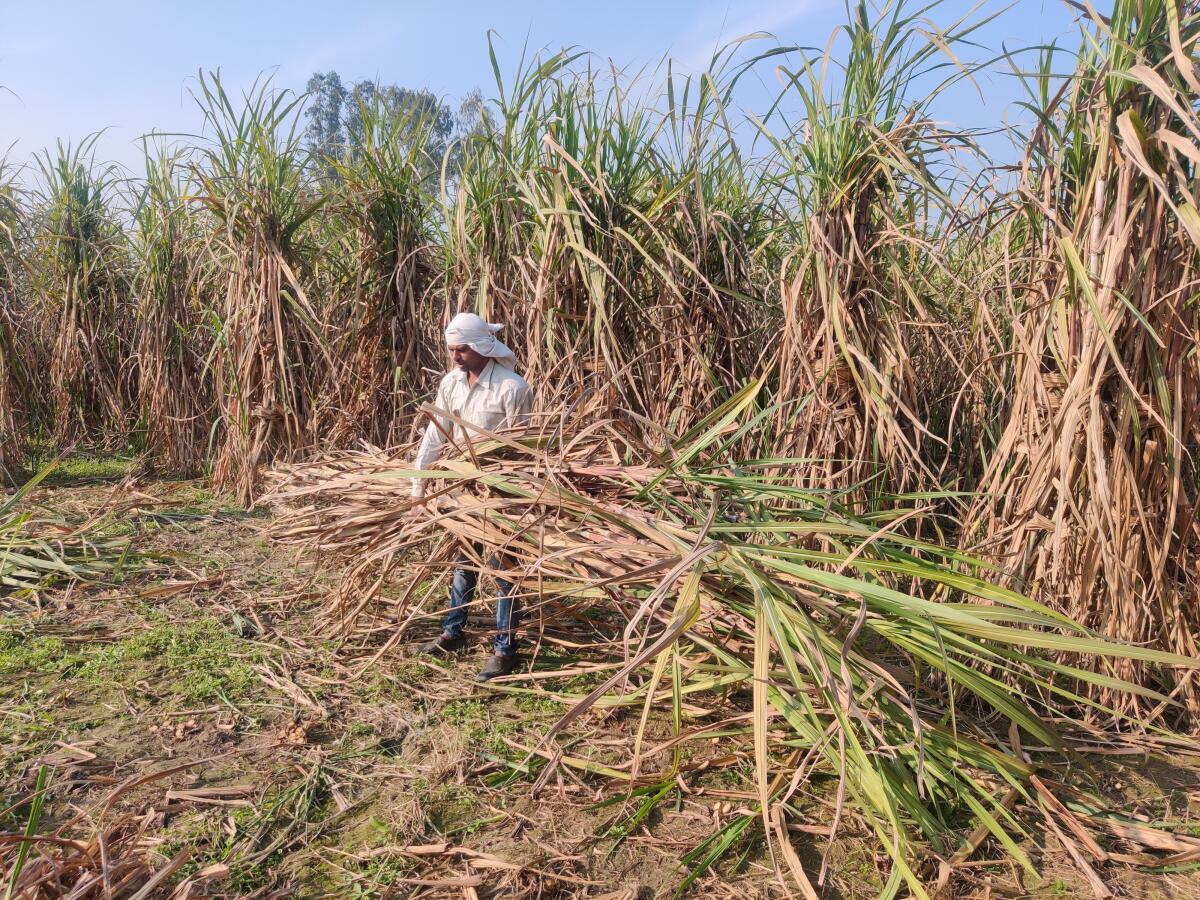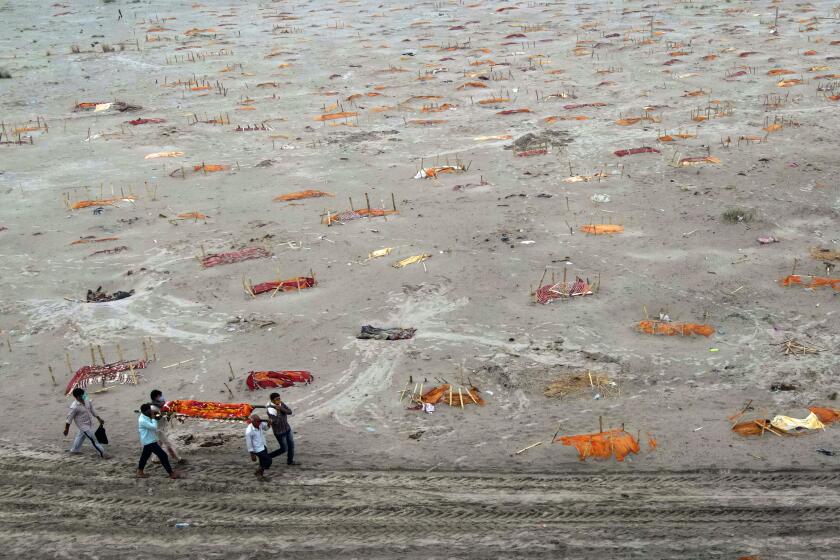No way out: The dangerous fields of India’s impoverished sugar-cane cutters

- Share via
BEED, India — Urmila Owhal became a bride at 13. The sooner she married, the quicker she could earn money in the sugar-cane fields, where contractors preferred hiring couples — one person to chop, the other to load cane onto trucks.
During a 14-hour workday in the stale, dry air of India’s sugar belt, Owhal heaved a 50-pound bundle of cane as tall as her fragile frame onto a flatbed truck. She lost her balance and fell, crushing her groin and spine. She and her husband had no choice but to borrow $2,000 from their contractor to pay for an operation — a sum double what the couple would earn from six months of labor.
That January day in Maharashtra state left Owhal with a limp. She can’t fold her legs when she sits. Her broken body yearns to rest, but like hundreds of thousands of other desperate rural Indians, she must head into the sugar fields.
“I have no choice,” said Owhal, 23, whose debt remains unpaid. “I will sit and wrap the bundles of cane. I will do as much as I can to help my husband. I will take painkillers. If I don’t go, he will lose his job.”
Owhal’s dependence on sugar cane is by design. Cheap and easily exploitable migrant workers are needed to power a $1.7-billion Indian sugar industry, second in size only to Brazil’s. By extending loans and paying workers in advance for often unrealistic harvest quotas, contractors effectively trap sugar-cane cutters in cycles of bonded labor.

Women bear the brunt of this cruel arrangement. Many are injured on the job, in the unending pressure to produce more. They live in squalor by the sides of fields, with no access to toilets. Infections and illness are common. Until a recent government crackdown, thousands of female sugar-cane cutters were tricked by predatory doctors into having medically unnecessary hysterectomies. Menstruation, they were told, slowed their productivity.
“The workers live in a makeshift hut of hay and tarpaulin,” said Manisha Tokle, an activist in Beed working to improve conditions in the fields. “They cook under the open sky, bathe and relieve themselves under the open sky. How are women supposed to manage?”
The hardship has existed for generations. Owhal’s parents were cane cutters, as were her husband’s. Her mother-in-law, Sojar Owhal, spent years on plantations, hunched over, thwacking stalks with a machete, then balancing bundles on her head to load onto trucks. The pressure to earn a day’s wage made her reluctant to take breaks. She blames the unrelenting fields for three miscarriages.

“I carried on as long as I could because we had already taken an advance,” said Sojar Owhal. “Once you accept money in advance, you are at the mercy of contractors.”
Education lifts many out of poverty in India, but COVID has closed schools. Now India is bracing for a surge in child labor and underage marriages.
Sojar Owhal, now 45, gave birth to her first child in a small clearing on a plantation, surrounded by fellow cutters. She was back to work 12 days later.
Like many agrarian families, the Owhals were drawn to sugar-cane cutting because farming alone can no longer sustain them. Fertilizer, pesticides and seeds have grown unaffordable. Climate change has unleashed floods, droughts and heat waves that ravage crops. Mounting hopelessness is driving thousands of farmers each year to die by suicide. The COVID-19 pandemic has only worsened the outlook for India’s 800 million rural dwellers.

“At best, we can hope to grow enough food for self-sustenance,” Sojar Owhal said. “But where do we get our cash from? You need money to pay your kids’ school fees. You need money when someone falls sick. Cutting cane is our only source of cash.”
Sojar Owhal’s weakening health prevents her these days from joining the autumn migration to the sugar fields — a tearful farewell of children waving goodbye to their young parents, who putter away on a tractor-pulled trolley blaring local Marathi songs or tunes from old Hindi films.
When the workers depart, there are few left in the village of Kathoda, just east of Beed. Cupboards and doors are padlocked; dirt roads go empty. Sojar Owhal spends her days with the elderly, the infirm and a handful of children. The stillness is broken only by the chirping of birds or a hot breeze ruffling leaves.
One of the villagers to leave Kathoda for the fields was Lata Waghmare, who has worked sugar cane for much of her life. Four years after getting married at 13, Waghmare was on a plantation when she heard a shriek. A co-worker had discovered Waghmare’s 5-month-old daughter crushed to death under a tractor. Her contractor forced her back to work the following day.
“He did not allow me time to grieve,” said Waghmare, who, like most mothers cutting cane, had no choice but to set her child down close to where she worked. “To this day, I blame myself for what happened to my daughter.”
Waghmare, now 32, had three more children. After the last was born 12 years ago, a doctor persuaded her to have a hysterectomy for dubious medical reasons. Waghmare agreed, believing it would allow her to work longer. She was never warned of the potential side effects — mood swings, dizziness — that torment her to this day.

“I did what I thought was important at the time for our survival,” she said. “If you are not efficient, you don’t get money. I couldn’t afford to lag behind due to my period cramps. We didn’t have toilets at the sugar-cane sites.”
Bodies are piling up by the Ganges, but lack of government data is obscuring the true extent of COVID-19 in rural India.
Local lawmakers have tried to improve conditions, and some workers have unionized. But no meaningful reforms have changed the industry. Since their employment is informal, sugar-cane cutters are not subject to minimum wage laws and aren’t eligible for social security benefits.
India is the world’s largest consumer of sugar, making it big business for the so-called barons who dominate the trade. They include members of India’s political elite whose profits are guaranteed by government policies designed to prevent volatile shifts in wholesale prices for the commodity. The sugar barons’ use of third-party contractors to hire cane cutters creates the illusion of a firewall between them and the miserable working conditions they impose on migrant laborers, activists say.
“They make such handsome profits yet continue to exploit sugar-cane cutters,” said Ashok Tandge, a workers’ advocate based in Beed. “The least they can do is pay them decent wages and ensure basic facilities at the work site.”

Hanumant Mundhe, a contractor based in Beed, said sugar mills were to blame for the poor working conditions. He said his job was limited to recruiting enough workers and paying the advance.
“The facilities are supposed to be provided by the sugar factory,” Mundhe said. “They get water in some cases, but I have not seen anyone providing the workers with toilets. They have to go in the fields. This is how it has been for years.”
Omprakash Babarao Kadu, minister of labor for Maharashtra, did not respond to a request for comment.
A survey released last year by Makaam, a coalition of women’s organizations and health advocates, revealed that 44% of female sugar-cane cutters had no access to water at work sites, 99% had no access to toilets and 86% had no access to electricity. Nearly 20% of respondents said they gave birth in the sugar fields, and more than 10% said they had an abortion during cutting season. About 3% said they encountered some form of sexual harassment on the job.
Urmila Owhal and her husband, Krishna Owhal, are now back in western Maharashtra, 250 miles from home in Kathoda. It’s her first cutting season since her injury. When she needs to relieve herself, she must walk deep into the fields to find privacy. She fears slipping and worsening her injury along the trek, then worries about the distance to the nearest clinic and how little her contractor would care if anything were to go wrong. Despite all that, staying in Kathoda was never an option. Farming there carries too much risk.
“You work hard on your land for months, and then it could all be destroyed after a 20-minute hailstorm,” she said.

A sense of fatalism imbues Owhal, a mother of two. She has known no other way of life. Sugar-cane cutting saddles her with debt but provides just enough so her family can eat.
“No matter what happens,” she said, “I don’t think we will ever be able to escape the sugar-cane fields.”
Special correspondent Parth M.N. reported from Beed and Times staff writer Pierson from Singapore.
More to Read
Sign up for Essential California
The most important California stories and recommendations in your inbox every morning.
You may occasionally receive promotional content from the Los Angeles Times.
















